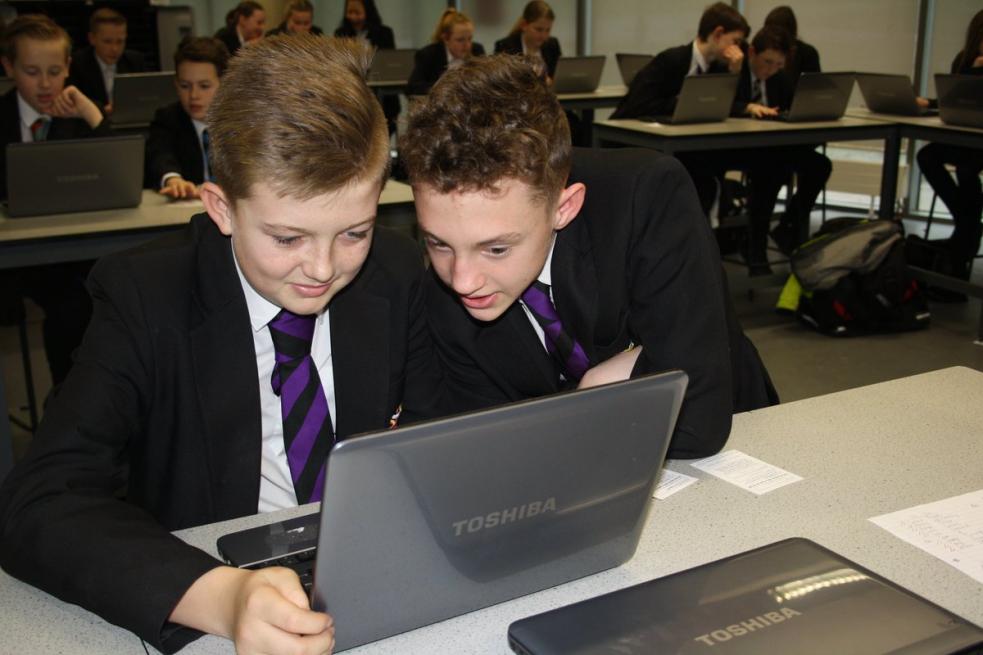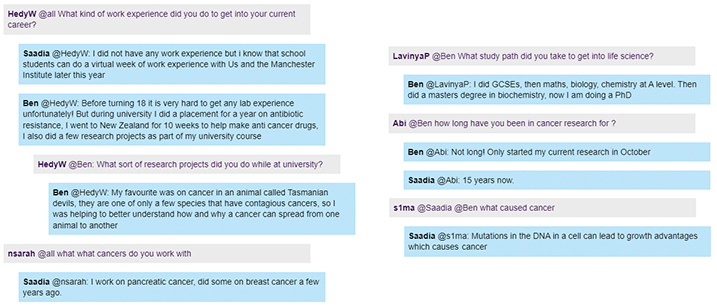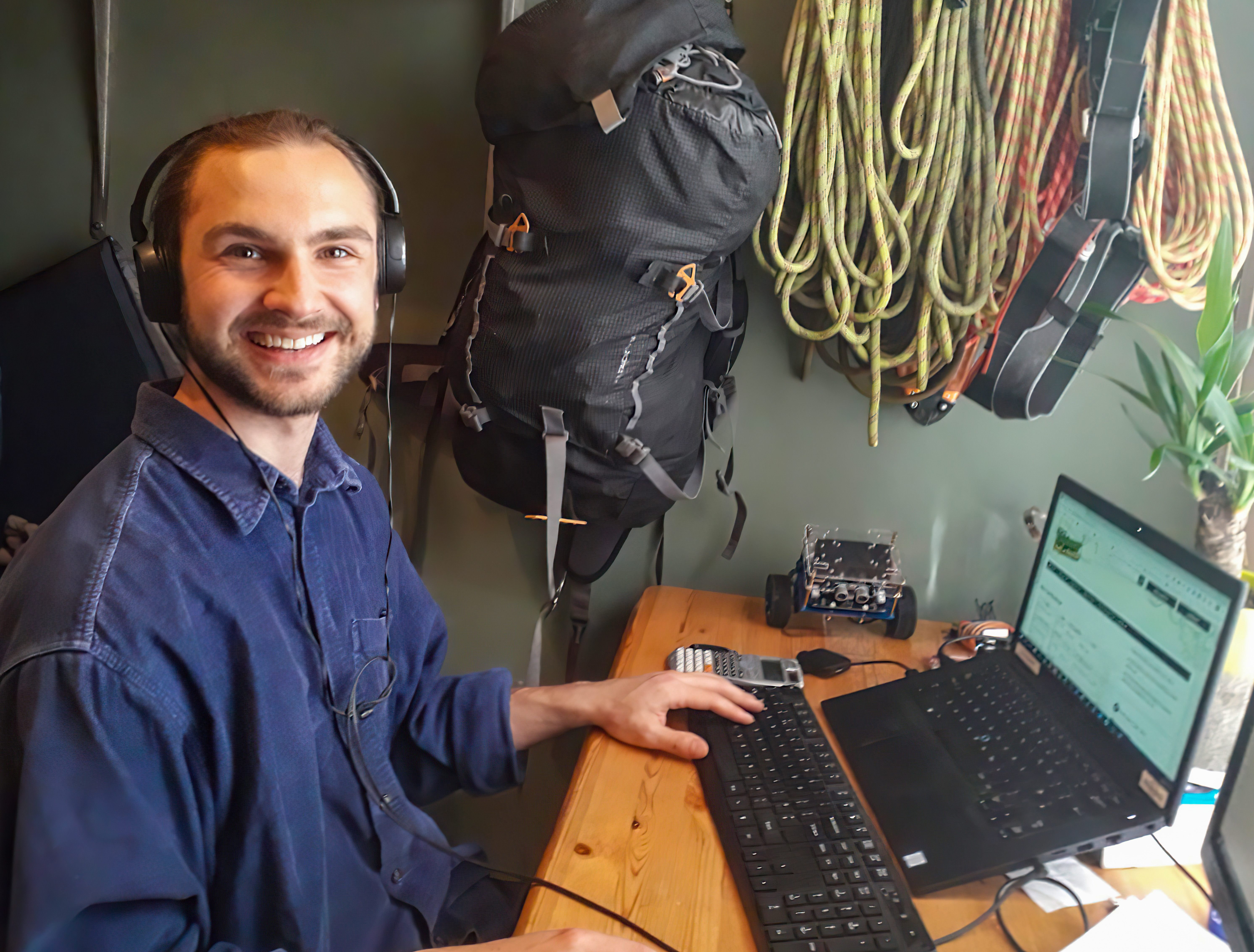I’m a Scientist Cancer Zone collaboration
The Cancer Zone was an online, student-led activity connecting school students with people working in cancer research. It offered staff the opportunity to build their public engagement skills in a low-risk but high-quality and effective way.

Project partners
- Jackie Beesley, Head of Research Management at Cancer Research UK Beatson Institute
- Monica Olcina del Molino, Junior Group Leader at the Oxford Institute for Radiation Oncology
- Dee Davison, Public Engagement Manager at the Institute of Genetics and Cancer at the University of Edinburgh
- Suzanne Johnson, Lead for Social Responsibility at the Division of Cancer Sciences at the University of Manchester
- Shane McCracken, Director of Mangorolla CIC and creator of I’m a Scientist, Get me out of here
The aim of the collaboration was to build a culture of public engagement within the institutes by providing an opportunity for 40 staff members and researchers to improve their engagement and communication skills through a high quality, low-risk outreach activity.
Background
Public engagement professionals at research institutions face challenges in encouraging staff to take part in public engagement. Face-to-face engagement can be stressful and requires a significant amount of personal effort and time, which can be off-putting.
Many public engagement activities are ‘high risk’. They might require the researcher to spend more time preparing for the activity than on the engagement itself. There might be multiple factors out of the researcher’s control, which risk the activity ‘going wrong’ - from traffic delays to audience attention span, to confidence with public speaking.
Often, there is a lack of resources to provide the researcher with professional support, or to evaluate the impact of their engagement activity.
There are also few opportunities for experiential training, which can provide a low-risk environment for staff to gain the necessary skills and confidence they need to carry out effective and high-quality public engagement.
Approach
The Cancer Zone was a cancer research-themed activity hosted on the I’m a Scientist, Get me out of here online platform in June 2022.
Mangorolla CIC’s flagship project I’m a Scientist (IAS) has been running since 2008, and connects school students with people working in STEM, through live, text-based Chats. Teachers can book Chats with researchers in advance, and on average each Chat features 5 or more researchers. The Chats are facilitated by DBS-checked moderators.
The online IAS platform is low-risk. It enables researchers to engage effectively with a large number of students concurrently; providing what feels like a 1-to-1 conversation in a flexible and accessible way, with little to no preparation required.
The Cancer Zone provided an excellent experiential training opportunity. Throughout the 4-week activity, people working in cancer research engaged with students multiple times, gaining more experience, and building on their newfound knowledge and skills week by week. The participating students represented a range of abilities and different levels of scientific knowledge and literacy.
The IAS approach supports students’ science capital and encourages two-way engagement. In the Cancer Zone, students could ask researchers questions about things that were important to them - from topics relevant to their curriculum, to researchers’ work and their lives outside of work. This enabled students to see how research is relevant to them and their lives and helped to challenge common ‘clever scientist’ stereotypes.
 Snapshot of online chats between students and researchers
Snapshot of online chats between students and researchers
Outside of the Chats, researchers were asked follow-up questions via the Ask feature. Here, they could give more in-depth and thoughtful responses to students’ questions.
Researchers were also invited to take part in the Academy Zone. This Zone is exclusively for researchers and offers an opportunity to reflect on their IAS experience. Participants learned more about two-way engagement and science capital, with guidance and feedback from their peers and Science Communication lecturer Dr Hannah Little. They were supported to better articulate the skills and knowledge they have gained from engaging with students, deepened their understanding of public engagement principles, and developed more effective future outreach activities.
Evaluation
As part of the evaluation process, the partner institutes asked their staff for feedback through an online survey. One-to-one interviews with a select number of researchers were also conducted to gain more in-depth qualitative feedback, and to better understand key barriers to taking part.
A handful of barriers were highlighted in feedback sessions. Researchers who were less active in the Cancer Zone reported that, while they wanted to be able to participate fully, work commitments led them to opting out. For example, their workload may have increased unexpectedly, so they were unable to make time to participate. For others, the 40-minute Chats were slightly too long to fit into a standard half-hour lunch break, so they could not take part during the workday.
Researchers who were able to participate more fully also reported that, due to the informal, online nature of the Chats, last-minute cancellations were more likely than they would be in formal face-to-face engagement. One researcher remarked that “I'd arranged time out of my day to do the chat … that then got cancelled without any notice.”
The feedback also highlighted a number of positive outcomes. Researchers widely reported that they gained a new perspective on their research: 67% said they felt more enthusiastic about their research area.
“Many students knew someone who has or had cancer … [the activity] gave them an opportunity to meet people who may have similar backgrounds to them and they could see where their future paths could lead.”
Others highlighted that they could clearly see evidence of how the IAS approach supported students’ science capital. One said, “Many students knew someone who has or had cancer … [the activity] gave them an opportunity to meet people who may have similar backgrounds to them and they could see where their future paths could lead.” Another noted that they were engaging with “students who might not have ever spoken to a scientist informally before. I wish I’d had access to something like that when I was at school!”. The majority said that their interest in taking part in future engagement activities had increased.
Though feedback was not requested directly from students, it is clear from the Chat transcripts that students responded to the conversations in different and highly personalised ways. In one very personal example, a student asked about the possible outcomes of their father’s cancer research treatment. In other Chats, students focused on their career paths (“I feel a lot more confident about a possible future in medicine now”).

Lessons learned
Collaborations, like the Cancer Zone, are essential for improving science engagement opportunities across the whole country. The benefits of collaboration are numerous.
Firstly, involving four institutes from across the country facilitates more diversity than one. Institutes working individually tend to focus on their local area and audiences, while working with others gives them an impetus to work on a wider scale. This provides more opportunities for researchers to speak to more diverse audiences, and for students - including those who typically miss out on face-to-face engagement - to connect with researchers from all over.
Collaboration also helps to overcome a key challenge: funding. High-quality public engagement activities benefit from economies of scale. Sharing the cost across four budgets is more efficient and more achievable than each institute investing time and money separately.
There were inevitably barriers related to it being an online activity - last minute cancellations, limited time of teachers to navigate a new platform, and different levels of digital access - that we will take measures to address for future projects. However, we think being online offers significant opportunities. It meant we could provide an equitable and high-quality activity, which was accessible to every student, from anywhere. Students also had a more private setting in which to ask their questions, some of which were very sensitive and personal.
Legacy
With funding, we would like to see the Cancer Zone run again in the future. This would ideally be with a fresh cohort of researchers to give students a deeper understanding of the breadth of the field, and the diversity of expertise needed for cancer research.
Research shows that young students who experience multiple interventions from STEM enrichment programmes are more likely to see STEM as something ‘for them’ as they move through the education system. With that in mind, teachers who had already expressed interest in the Cancer Zone could be invited to book a live Chat again.
The co-funded, collaborative nature of programmes like the Cancer Zone has a disproportionately positive impact on legacy. The activity could run again in the future, even if one funder dropped out for a cycle. Learning curves continue, the activity becomes more efficient, evaluation evolves.
The wider I’m a Scientist project is also more likely to succeed. A stable online programme means that, year after year, more researchers from across disciplines can participate, reap the benefits of participation, and encourage colleagues to sign up for the next time. With scientists taking part from their office, engagement becomes more visible in the workplace, building on the culture of good engagement practice. It becomes a virtuous circle - and in turn makes it easier for public engagement staff to rally support and enthusiasm for future activities and programmes.
Find out more
If you would like to find out more, please contact Shane McCracken at shane@mangorol.la or visit the I'm a Scientist UK website.